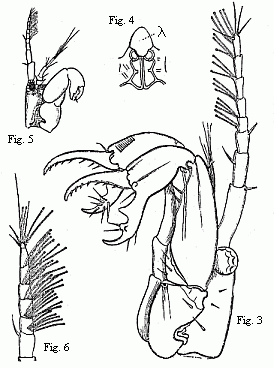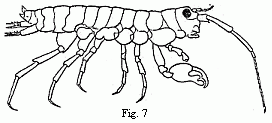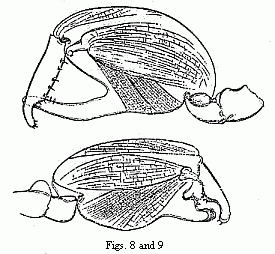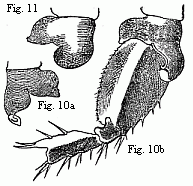
Our Tanais, which in nearly all the particulars of its structure is an extremely remarkable animal, furnished me with a second fact worthy of notice in connection with the theory of the origin of species by natural selection.
When hand-like or cheliform structures occur in the Crustacea, these are usually more strongly developed in the males than in the females, often becoming enlarged in the former to quite a disproportionate size, as we have already seen to be the case in Melita. A better known example of such gigantic chelæ is presented by the males of the Calling Crabs (Gelasimus), which are said in running to carry these claws “elevated, as if beckoning with them”—a statement which, however, is not true of all the species, as a small and particularly large-clawed one, which I have seen running about by thousands in the cassava-fields at the mouth of the Cambriú, always holds them closely pressed against its body.
A second peculiarity of the male Crustacea consists not unfrequently in a more abundant development on the flagellum of the anterior antennæ of delicate filaments which Spence Bate calls “auditory cilia,” and which I have considered to be olfactory organs, as did Leydig before me, although I was not aware of it. Thus they form long dense tufts in the males of many Diastylidæ, as Van Beneden also states with regard to Bodotria, whilst the females only possess them more sparingly. In the Copepoda, Claus called attention to the difference of the sexes in this respect. It seems to me, as I may remark in passing, that this stronger development in the males is greatly in favour of the opinion maintained by Leydig and myself, as in other cases male animals are not unfrequently guided by the scent in their pursuit of the ardent females.
Now, in our Tanais, the young males up to the last change of skin preceding sexual maturity resemble the females, but then they undergo an important metamorphosis. Amongst other things they lose the moveable appendages of the mouth even to those which serve for the maintenance of the respiratory current; their intestine is always found empty, and they appear only to live for love. But what is most remarkable is, that they now appear under two different forms. Some (Fig. 3) acquire powerful, long-fingered, and very mobile chelæ, and, instead of the single olfactory filament of the female, have from 12 to 17 of these organs, which stand two or three together on each joint of the flagellum. The others (Fig. 5) retain the short thick form of the chelæ of the females; but, on the other hand, their antennæ (Fig. 6) are equipped with a far greater number of olfactory filaments, which stand in groups of from five to seven together.

Fig. 3. Head of the ordinary form of the male of Tanais dubius (?) Kr. magnified. The terminal setæ of the second pair of antennæ project between the cheliferous feet.
Fig. 4. Buccal region of the same from below; λ, labrum.
Fig. 5. Head of the rarer form of the male, magnified.
Fig. 6. Flagellum of the same, with olfactory filaments, magnified.
In the first place, and before inquiring into its significance, I will say a word upon this fact itself. It was natural to consider whether two different species with very similar females and very different males might not perhaps live together, or whether the males, instead of occurring in two sharply defined forms, might not be only variable within very wide limits. I can admit neither of these suppositions. Our Tanais lives among densely interwoven Confervæ, which form a coat of about an inch in thickness upon stones in the neighbourhood of the shore. If a handful of this green felt is put into a large glass with clear sea-water, the walls of the glass are soon seen covered with hundreds, nay with thousands, of these little, plump, whitish Isopods. In this way I have examined thousands of them with the simple lens, and I have also examined many hundreds with the microscope, without finding any differences among the females, or any intermediate forms between the two kinds of males.
To the old school this occurrence of two kinds of males will appear to be merely a matter of curiosity. To those who regard the “plan of creation” as the “free conception of an Almighty intellect, matured in the thoughts of the latter before it is manifested in palpable, external forms,” it will appear to be a mere caprice of the Creator, as it is inexplicable either from the point of view of practical adaptation, or from the “typical plan of structure.” From the side of Darwin’s theory, on the contrary, this fact acquires meaning and significance, and it appears in return to be fitted to throw light upon a question in which Bronn saw “the first and most material objection against the new theory,” namely, how it is possible that from the accumulation in various directions of the smallest variations running out of one another, varieties and species are produced, which stand out from the primary form clearly and sharply like the petiolated leaf of a Dicotyledon, and are not amalgamated with the primary form and with each other like the irregular curled lobes of a foliaceous Lichen.
Let us suppose that the males of our Tanais, hitherto identical in structure, begin to vary, in all directions as Bronn thinks, for aught I care. If the species was adapted to its conditions of existence, if the best in this respect had been attained and secured by natural selection, fresh variations affecting the species as a species would be retrogressions, and thus could have no prospect of prevailing. They must rather have disappeared again as they arose, and the lists would remain open to the males under variation, only in respect of their sexual relations. In these they might acquire advantages over their rivals by their being enabled either to seek or to seize the females better. The best smellers would overcome all that were inferior to them in this respect, unless the latter had other advantages, such as more powerful chelæ, to oppose to them. The best claspers would overcome all less strongly armed champions, unless these opposed to them some other advantage, such as sharper senses. It will be easily understood how in this manner all the intermediate steps less favoured in the development of the olfactory filaments or of the chelæ would disappear from the lists, and two sharply defined forms, the best smellers and the best claspers, would remain as the sole adversaries. At the present day the contest seems to have been decided in favour of the latter, as they occur in greatly preponderating numbers, perhaps a hundred of them to one smeller.
To return to Bronn’s objection. When he says that “for the support of the Darwinian theory, and in order to explain why many species do not coalesce by means of intermediate forms, he would gladly discover some external or internal principle which should compel the variations of each species to advance in one direction, instead of merely permitting them in all directions,” we may, in this as in many other cases, find such a principle in the fact that actually only a few directions stand open in which the variations are at the same time improvements, and in which therefore they can accumulate and become fixed; whilst in all others, being either indifferent or injurious, they will go as lightly as they come.

Fig. 7. Orchestia Darwinii, n. sp. male.
The occurrence of two kinds of males in the same species may perhaps not be a very rare phenomenon in animals in which the males differ widely from the females in structure. But only in those which can be procured in sufficient abundance, will it be possible to arrive at a conviction that we have not before us either two different species, or animals of different ages. From my own observation, although not very extensive, I can give a second example. It relates to a shore-hopper (Orchestia). The animal (Fig. 7) lives in marshy places in the vicinity of the sea, under decaying leaves, in the loose earth which the Marsh Crabs (Gelasimus, Sesarma, Cyclograpsus, etc.) throw up around the entrance to their borrows, and even under dry cow-dung and horse-dung. If this species removes to a greater distance from the shore than the majority of its congeners (although some of them advance very far into the land and even upon mountains of a thousand feet in height, such as O. tahitensis, telluris, and sylvicola), its male differs still more from all known species by the powerful chelæ of the second pair of feet. Orchestia gryphus, from the sandy coast of Monchgut, alone presents a somewhat similar structure, but in a far less degree; elsewhere the form of the hand usual in the Amphipoda occurs. Now there is a considerable difference between the males of this species, especially in the structure of these chelæ—a different so great that we can scarcely find a parallel to it elsewhere between two species of the genus—and yet, as in Tanais, we do not meet with a long series of structures running into one another, but only two forms united by no intermediate terms (Figs. 8 and 9). The males would be unhesitatingly regarded as belonging to two well-marked species if they did not live on the same spot, with undistinguishable females. That the two forms of the chelæ of the males occur in this species is so far worthy of notice, because the formation of the chelæ, which differs widely from the ordinary structure in the other species, indicates that it has quite recently undergone considerable changes, and therefore such a phenomenon was to be expected in it rather than in other species.

Figs. 8 and 9. The two forms of the chelæ of the male of Orchestia Darwinii, magnified.
I cannot refrain from taking this opportunity of remarking that (so far as appears from Spence Bate’s catalogue), for two different kinds of males (Orchestia telluris and sylvicola) which live together in the forests of New Zealand, only one form of female is known, and hazarding the supposition that we have here a similar case. It does not seem to me to be probable that two nearly allied species of these social Amphipoda should occur mixed together under the same conditions of life.

Fig. 10. Coxal lamella of the penultimate pair of feet of the male (a), and coxal lamella, with the three following joints of the same pair of feet of the female (b) of Melita Messalina, magnified.
Fig. 11. Coxal lamella of the same pair of feet of the female of M. insatiabilis.
As the males of several species of Melita are distinguished by the powerful unpaired clasp-forceps, the females of some other species of the same genus are equally distinguished from all other Amphipoda by the circumstance that in them a peculiar apparatus is developed which facilitates their being held by the male. The coxal lamellæ of the penultimate pair of feet are produced into hook-like processes, of which the male lays hold with the hands of the first pair of feet. The two species in which I am acquainted with this structure are amongst the most salacious animals of their order, even females which are laden with eggs in all stages of development, not unfrequently have their males upon their backs. The two species are nearly allied to Melita palmata Leach (Gammarus Dugesii, Edw.), which is widely distributed on the European coasts, and has been frequently investigated; unfortunately, however, I can find no information as to whether the females of this or any other European species possess a similar contrivance. In M. exilii all the coxal lamellæ are of the ordinary formation. Nevertheless, be this as it will, whether they exist in two or in twenty species, the occurrence of these peculiar hook-like processes is certainly very limited.
Now our two species live sheltered beneath slightly tilted stones in the neighbourhood of the shore: one of them, Melita Messalina, so high that it is but rarely covered by the water; the other, Melita insatiabilis, a little lower; both species live together in numerous swarms. We cannot therefore suppose that the loving couples are threatened with disturbance more frequently than those of other species, nor would it be more difficult for the male, than for those of other species, in case of his losing his female, to find a new one. Nor is it any more easy to see how the contrivance on the body of the female for insuring the act of copulation could be injurious to other species. But so long as it is not demonstrated that our species are particularly in want of this contrivance, or that the latter would rather be injurious than beneficial to other species, its presence only in these few Amphipoda will have to be regarded not as the work of far-seeing wisdom, but as that of a favourable chance made use of by Natural Selection. Under the latter supposition its isolated occurrence is intelligible, whilst we cannot perceive why the Creator blessed just these few species with an apparatus which he found to be quite compatible with the “general plan of structure” of the Amphipoda, and yet denied it to others which live under the same external conditions, and equal them even in their extraordinary salacity. Associated with, or in the immediate vicinity of the two species of Melita, live two species of Allorchestes, the pairs of which are met with almost more numerously than the single animals, and yet their females show no trace of the above-mentioned processes of the coxal lamellæ.
These cases, I think, must be brought to bear against the conception supported with so much genius and knowledge by Agassiz, that species are embodied thoughts of the Creator; and, with these, all similar instances in which arrangements which would be equally beneficial to all the species of a group are wanting in the majority and only conferred upon a few special favourites, which do not seem to want them any more than the rest.